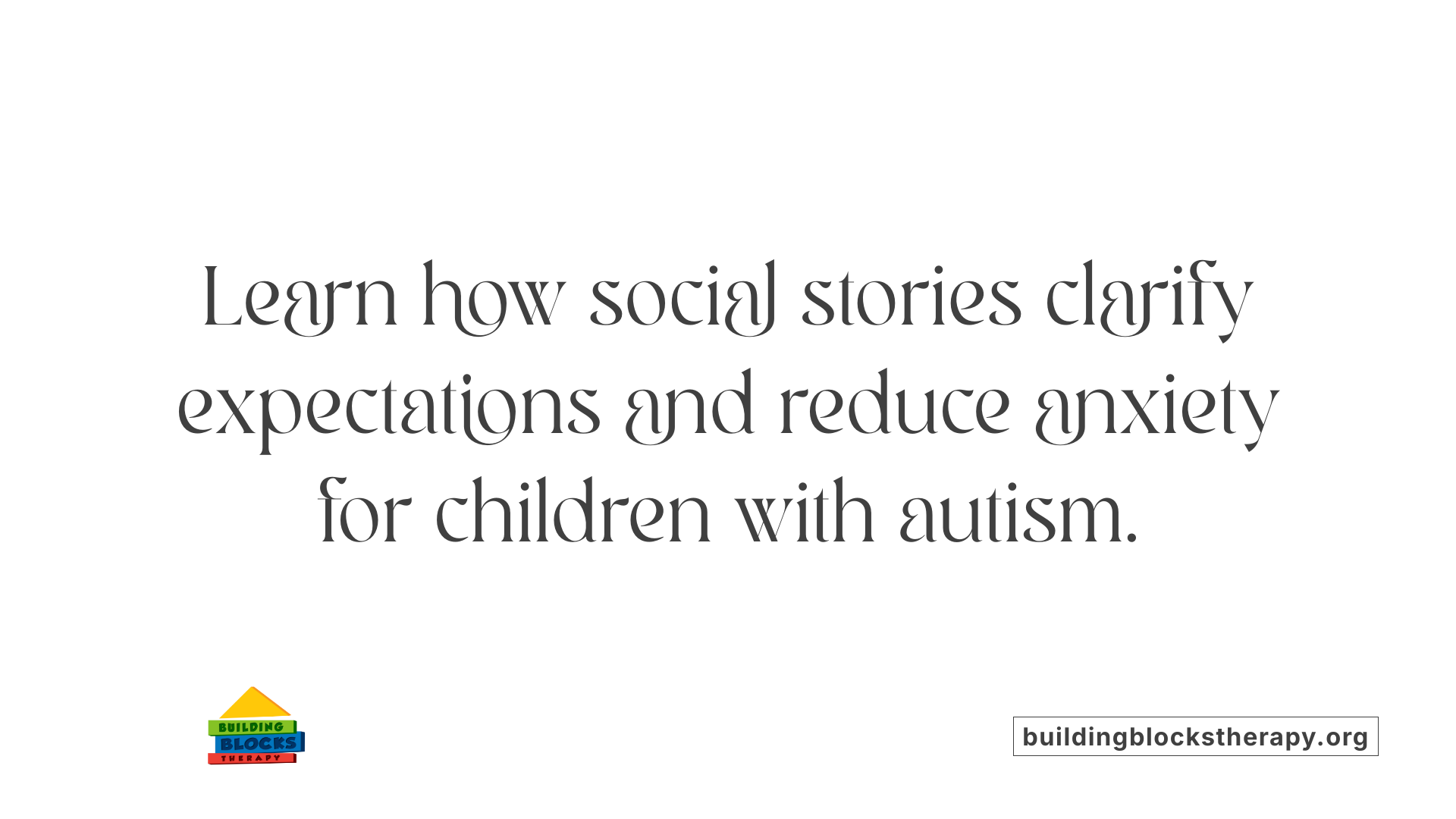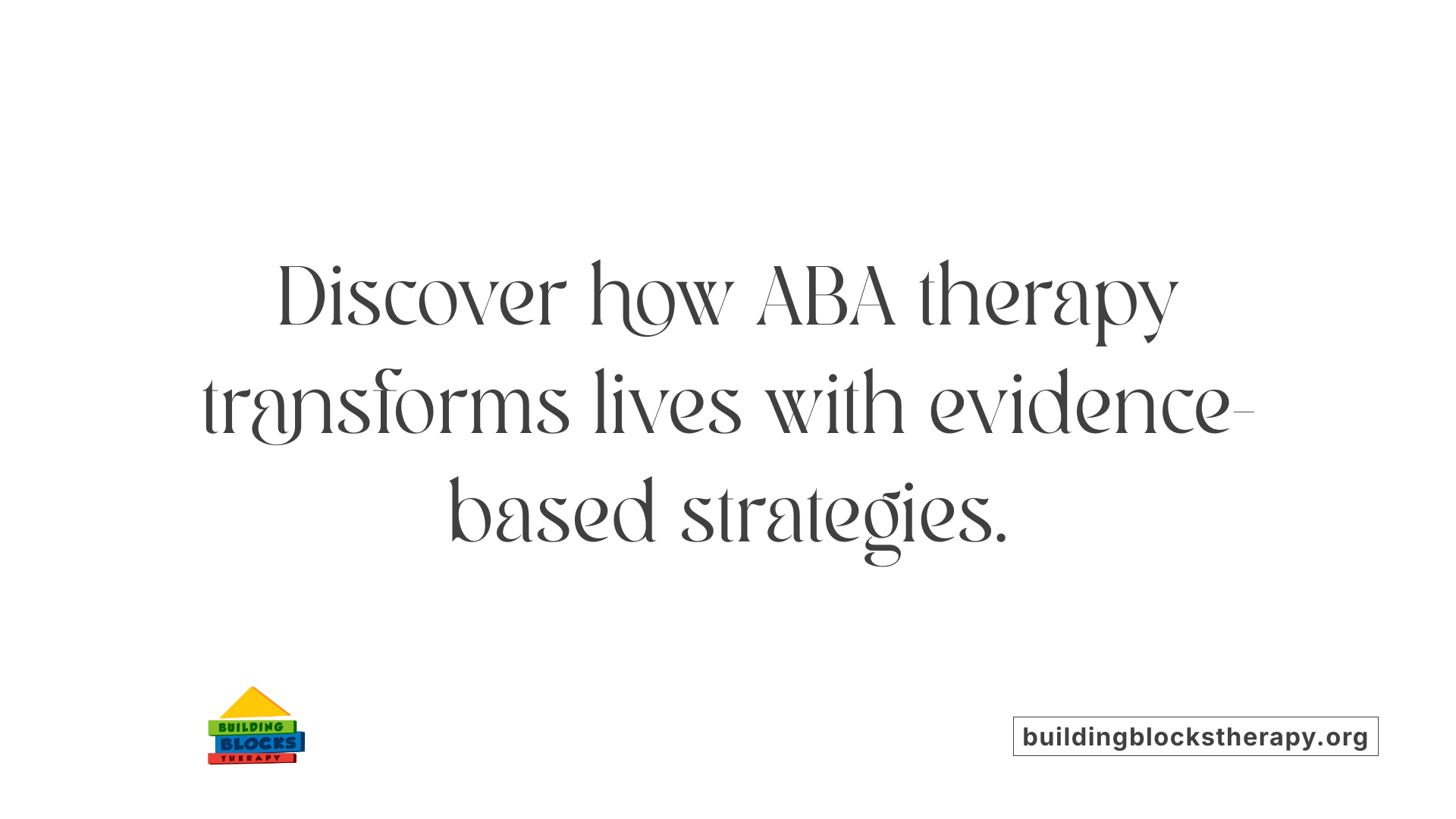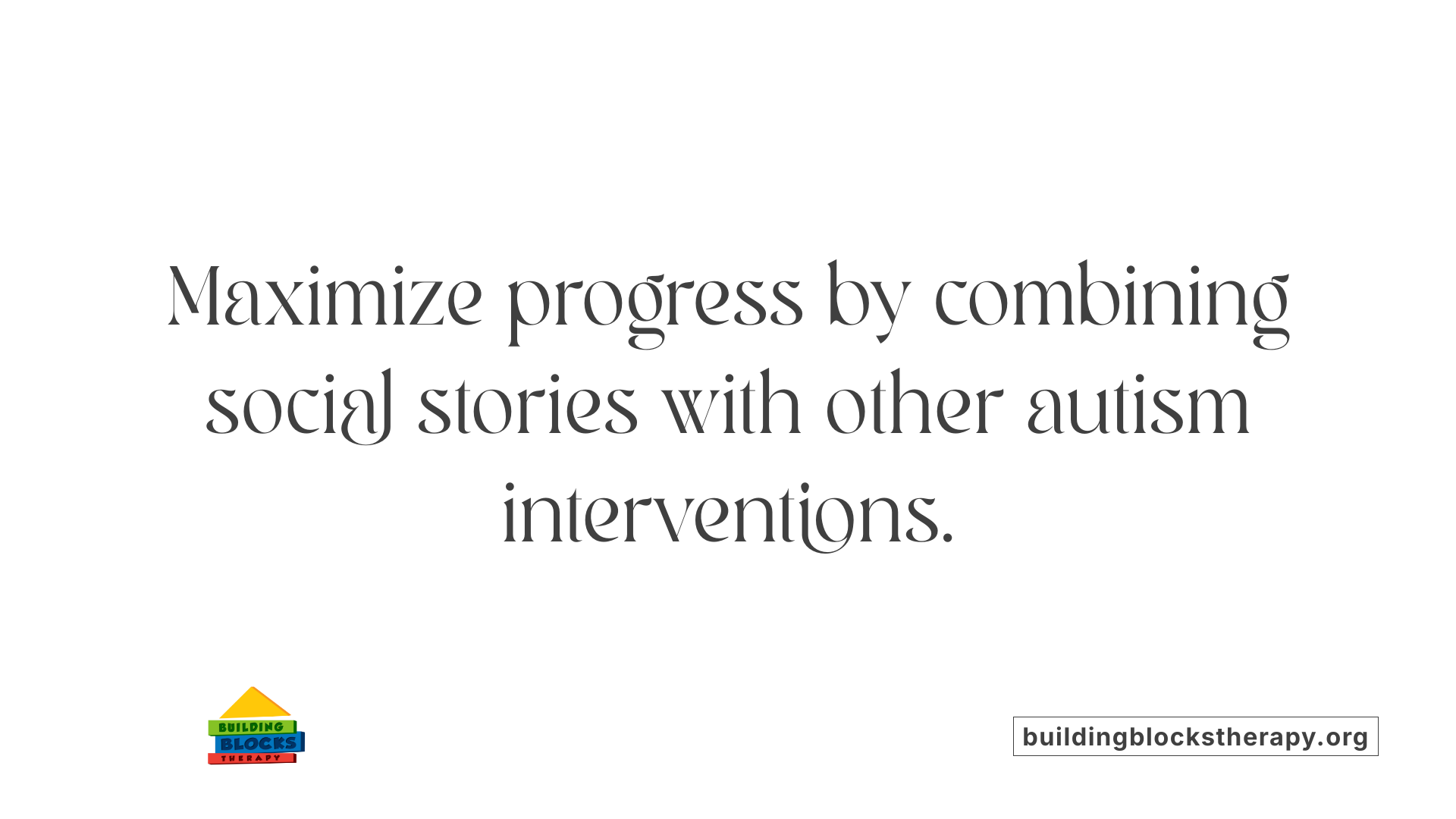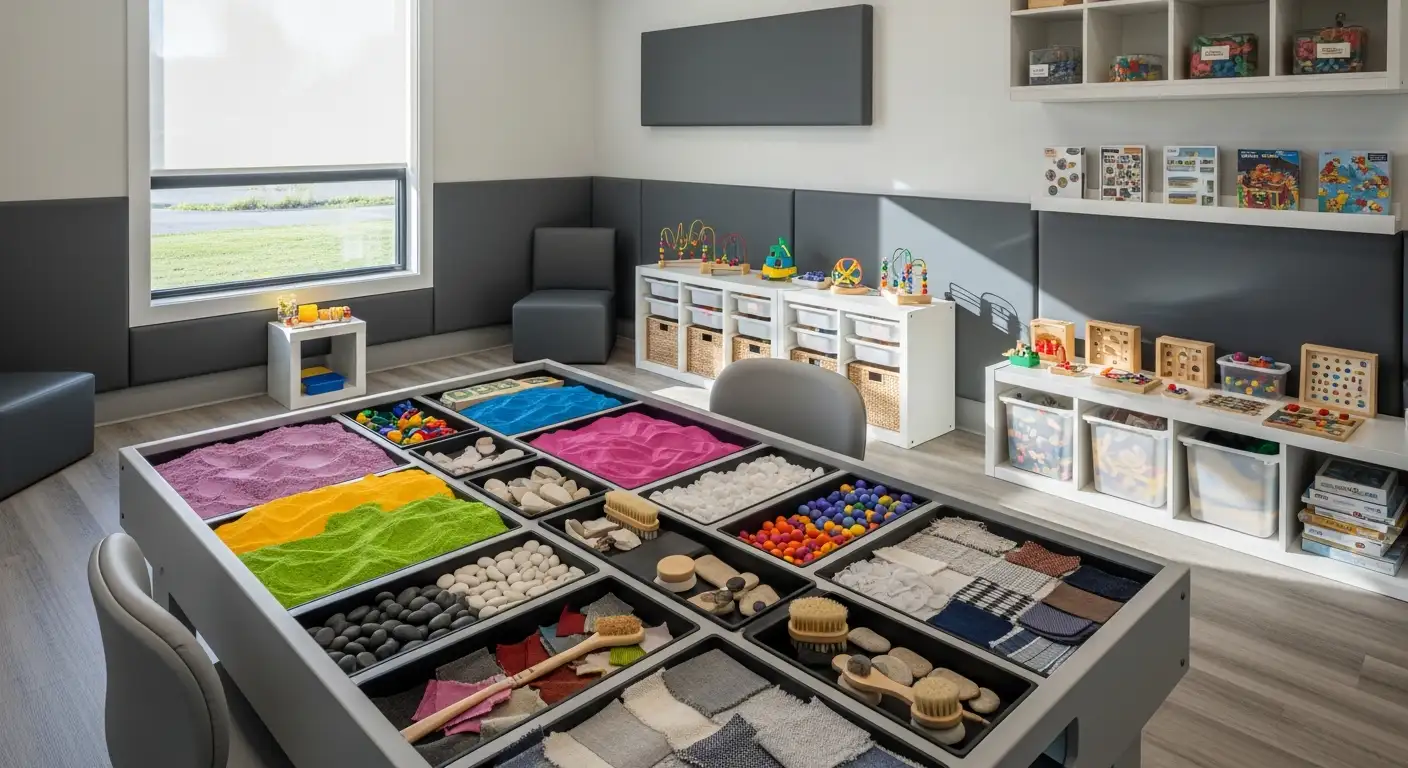Understanding the Role of Social Stories in Autism Therapy
Children with autism spectrum disorder (ASD) often face challenges in social communication and understanding social norms. Among various therapy tools, social stories have emerged as an effective way to improve comprehension of social situations, reduce anxiety, and build social skills. This article explores how social stories are incorporated into autism therapy, the role of Applied Behavior Analysis (ABA), and how these strategies complement other treatment approaches to support children with autism.
What Are Social Stories and How Do They Support Children with Autism?

Definition and Purpose of Social Stories
Social stories are brief, straightforward narratives designed to explain social situations, behaviors, or routines to children with autism. Their primary aim is to provide a clear understanding of social cues and expected responses, making social interactions more predictable and less overwhelming.
How Social Stories Improve Understanding of Social Norms and Expectations
By outlining specific social norms and expected behaviors, social stories help children with autism grasp unwritten social rules. This understanding supports smoother interactions and helps children learn how to respond appropriately to different social settings.
Use of Visual Supports to Aid Comprehension
Social stories often incorporate visual elements such as pictures or symbols, which complement the written text. These visual supports enhance comprehension, especially for children who have difficulty with verbal communication, by providing concrete representations of abstract social concepts.
Impact on Reducing Anxiety and Enhancing Social Interaction
Because social stories clarify what to expect in social situations, they help reduce anxiety that often arises from uncertainty. This increased confidence promotes better participation and engagement in social activities, ultimately improving social skills and emotional well-being for children with autism.
Incorporating Social Stories into ABA Therapy for Autism
How does ABA therapy utilize social stories?
Applied Behavior Analysis (ABA) therapy integrates social stories as an effective visual support to teach children with autism various social skills and expected behaviors.
ABA techniques focus on breaking down complex social interactions into manageable steps, and social stories help by providing clear, concrete examples of social norms and routines.
Therapists use positive reinforcement and behavior modification strategies alongside these stories to encourage the desired social behaviors.
ABA techniques supporting social story use
ABA's structured approach allows therapists to embed social stories into teaching sessions, enabling children to learn by observing and practicing modeled behaviors.
This method often includes prompting and systematic reinforcement to increase the child's understanding and social engagement.
How ABA data collection aids in customizing social stories
One of ABA's strengths is its data-driven nature, where therapists carefully monitor a child's responses to social stories.
By collecting detailed data on behavior changes and skill acquisition, therapists can adjust the content and presentation of social stories to better suit each child's needs.
This ongoing assessment ensures that social stories remain relevant and effective in promoting social understanding.
Collaboration with families and therapists
Successful incorporation of social stories in ABA involves collaboration between therapists, families, and other specialists.
Parents are often guided to use social stories consistently at home, reinforcing the skills learned during therapy.
This teamwork ensures a cohesive approach, helping children generalize social skills across different environments and improving overall outcomes.
Understanding Applied Behavior Analysis (ABA) Therapy and Its Benefits

What is Applied Behavior Analysis (ABA) therapy and how does it benefit individuals with autism?
ABA therapy is a scientifically supported method grounded in principles of learning and behavior. It is designed to assist individuals with autism in acquiring crucial skills and decreasing challenging behaviors. The therapy involves creating tailored programs that use positive reinforcement to encourage desirable behaviors.
How does ABA promote learning new behaviors?
ABA focuses on breaking down complex skills into smaller steps and systematically teaching them. By rewarding positive actions, it motivates individuals to repeat and strengthen these behaviors. This approach helps develop abilities in communication, social interaction, daily living, and problem-solving.
Effectiveness of ABA in autism intervention
Research consistently shows that ABA can significantly improve social, communication, and adaptive skills in children with autism. It can increase independence and reduce behaviors that interfere with learning or social engagement, providing long-term benefits when applied consistently.
Role of parent and caregiver training in ABA
Active involvement of parents and caregivers is a core component of ABA therapy. Training them to implement ABA techniques at home ensures skills learned in therapy generalize to everyday environments, reinforcing progress and improving overall outcomes.
Qualifications and Roles of Professionals Providing ABA Therapy
Who typically provides ABA therapy and what qualifications do they hold?
ABA therapy is generally provided by a team of specialized professionals, prominently featuring Board Certified Behavior Analysts (BCBAs). BCBAs are extensively trained and certified experts in applied behavior analysis, with a deep understanding of behavior principles and autism interventions. They design, oversee, and adjust individualized treatment plans based on thorough assessments.
Supporting the BCBAs are therapists and assistant behavior analysts who work directly with children. These individuals receive specialized training to carry out therapy sessions, collect data, and support behavior change strategies under the guidance of the supervising BCBA. Support staff may include behavioral technicians and aides, who help implement daily goals and assist with skill-building activities.
Importance of specialized training and certification
Specialized training and certification are critical in ABA therapy because they ensure adherence to evidence-based practices, maintaining both the quality and ethical standards of treatment. Certifications such as the BCBA credential require rigorous coursework, supervised clinical hours, and successful completion of a certification exam.
Ongoing professional development is essential to stay current with emerging research and techniques in autism therapy, ensuring that interventions remain effective and tailored to the child's evolving needs.
Family collaboration and experience in autism therapy
An integral component of ABA therapy delivery is collaboration with families. Providers are trained to engage parents and caregivers, empowering them to support therapeutic strategies at home and in community settings. Experienced therapists understand the unique challenges faced by families and work to create a nurturing, inclusive environment that honors the child's individuality and strengthens the family unit.
Through this multidisciplinary, well-trained team approach, ABA therapy can effectively target behaviors, develop new skills, and improve the overall quality of life for children with autism.
Core Techniques Used in ABA Therapy for Autism
What are some common techniques used in ABA therapy for autism?
ABA therapy utilizes a variety of strategies designed to teach and reinforce desirable behaviors while reducing undesired ones. Below are some of the most commonly used techniques:
Discrete Trial Training (DTT): This method breaks down skills into very small, manageable steps. Each step is taught one at a time through repeated trials, making learning structured and focused.
Natural Environment Teaching (NET): NET encourages learning within the child's everyday environment and activities. It uses natural situations as teaching moments to help generalize skills across settings.
Pivotal Response Treatment (PRT): PRT targets pivotal areas of a child's development such as motivation and initiation of communication. By boosting these pivotal behaviors, it helps improve social engagement and learning.
Modeling, Prompting, and Behavior Chaining: Therapists demonstrate desired behaviors (modeling), provide cues or assistance to encourage correct responses (prompting), and link together small behaviors into complex activities (behavior chaining) to promote skill acquisition.
Use of Reinforcement and Behavior Reduction Strategies: Positive behaviors are encouraged using rewards and praise (reinforcement), while undesired behaviors are reduced through strategies that discourage or replace them.
These techniques work together to create a supportive and effective learning environment tailored to each child's needs. By systematically teaching skills and reinforcing progress, ABA therapy helps children with autism make meaningful improvements in communication, social interactions, and daily functioning.
Comparing ABA Therapy to Other Autism Interventions
How does ABA therapy differ from other autism therapies?
ABA (Applied Behavior Analysis) therapy distinguishes itself by focusing on observable and measurable behaviors using structured, data-driven methods. It operates through reinforcement techniques to encourage desirable behaviors and reduce maladaptive ones. This empirical approach contrasts with developmental and social-relational therapies, which emphasize emotional bonding, social connections, and natural developmental progress.
Empirical and data-based nature of ABA
ABA's hallmark is its reliance on ongoing data collection and analysis to tailor interventions for each child. Therapists continuously measure behavioral progress, allowing adjustments to optimize outcomes. This evidence-based framework is a defining feature that ensures ABA remains goal-focused and outcome-oriented.
Differences from developmental and social-relational approaches
Developmental approaches, such as speech and occupational therapy or the Early Start Denver Model, emphasize enhancing language, social skills, and physical abilities through naturalistic interactions and play. Social-relational models like DIR (Floor Time) and social skills groups prioritize emotional relationships and social engagement over strict behavioral measurement. ABA targets specific behaviors individually, while these approaches foster broader developmental and emotional growth.
Integration with other therapies like speech and occupational therapy
Although ABA is distinct, it is often combined with developmental therapies to provide comprehensive support. Speech and occupational therapy complement ABA by addressing communication challenges and motor skills, enabling a more holistic intervention plan tailored to the child’s unique needs.
ABA’s focus on observable behavior and reinforcement
At its core, ABA concentrates on the environment’s role in shaping behavior using positive reinforcement strategies. This focus on tangible behavior change and environmental interaction helps create structured learning experiences, differentiating ABA from therapies that rely more on emotional expression or unstructured play.
In summary, ABA therapy offers an evidence-supported, behavior-focused approach that contrasts with more holistic developmental and social-relational interventions but is often integrated with them to enhance outcomes for children with autism.
Setting Goals in ABA Therapy to Support Children with Autism
What goals does ABA therapy typically aim to achieve for individuals with autism?
ABA therapy prioritizes helping children with autism develop essential skills across various areas, including communication, social interaction, daily living, and academic performance. The goals set in this therapy are highly personalized and measurable, allowing for targeted support tailored to each child's unique needs.
Personalized and measurable goal setting
Each child’s therapy plan begins with setting specific, achievable goals that are regularly evaluated to track progress. This personalized approach ensures that the therapy remains relevant and effectively addresses areas requiring improvement.
Focus on communication, social skills, daily living, and academics
ABA therapy addresses multiple skill domains. Communication goals might include increasing verbal interactions, while social skills goals target peer engagement and turn-taking. Daily living skills focus on routines such as dressing or hygiene, and academic goals support learning and classroom behavior.
Use of positive reinforcement to encourage progress
The therapy employs positive reinforcement techniques to encourage desired behaviors. Rewards and incentives motivate children to practice and maintain new skills, fostering confidence and independence.
Ongoing data collection and goal adjustment
Professionals continuously collect data during therapy sessions to monitor the child's development. This ongoing assessment allows therapists to adjust goals and strategies, ensuring the interventions remain effective and aligned with the child's evolving needs.
The Role of Play Therapy and Complementary Tools in Autism Treatment

What is the Child-Centered Approach of Play Therapy?
Play therapy for children with autism focuses on engaging them in play activities of their choosing. This child-centered model allows children to express themselves naturally through toys and play rather than relying solely on verbal communication. This approach is especially beneficial for children with limited verbal skills, providing a comfortable space tailored to their interests and communication preferences.
What Are the Benefits of Play Therapy in Communication and Social Skills Development?
Play therapy helps children with autism improve both verbal and nonverbal communication by encouraging expression in a low-pressure setting. It supports development of social and emotional skills, foster empathy, and aids in emotional regulation. Additionally, play therapy improves fine and gross motor skills and reduces maladaptive behaviors by accepting children as they are. Overall, it offers a nurturing environment that promotes relationship-building and social interaction.
How Do Sensory, Pretend Play, and Role-Playing Techniques Work in Therapy?
Various techniques are used in play therapy, including sensory activities, pretend play, role-playing, storytelling, and arts and crafts. These can be structured or unstructured depending on therapeutic goals. For example, role-playing can enhance social interaction skills, while sensory activities help children process sensory input. Pretend play encourages creativity and problem-solving, all contributing to a child's developmental progress.
How Can Tools Like Forbrain Enhance Therapy Outcomes?
Forbrain is an auditory stimulation device that enhances attention, memory, and self-awareness. When combined with play therapy, it can increase a child's engagement and responsiveness, making therapy more effective. Such complementary tools support the improvements in communication and cognitive skills gained through play therapy, leading to better overall outcomes.
How Can Play Therapy Complement ABA and Social Stories?
Play therapy provides a child-centered environment emphasizing natural expression through play, complementing Applied Behavior Analysis (ABA) and social stories. While ABA uses behavioral reinforcement to encourage desired actions and social stories use visual supports to clarify social norms, play therapy adds an emotional and creative element. This multi-modal approach caters to diverse learning needs, improving the effectiveness of autism interventions.
Communication Challenges in Autism and Strategies to Support Them
What are the core social communication differences in autism?
Children with autism often experience significant differences in social communication that impact their ability to interact with others. These differences can include difficulty understanding social cues, challenges in initiating and maintaining conversations, and a preference for solitary or repetitive activities. Such communication barriers affect social skills and make everyday interactions more challenging.
How do visual supports reduce communication barriers?
Visual supports play a crucial role in bridging communication gaps for children with autism. Tools like social stories provide clear, visual explanations to describe social norms, routines, and expectations. By offering concrete representations of abstract social concepts, visual supports reduce confusion and enhance understanding. This approach can alleviate anxiety and support smoother social interactions.
Why is individualized communication intervention important?
Each child with autism has unique communication needs and strengths, making tailored interventions essential. Individualized communication strategies address specific challenges by using customized supports such as pictures, gestures, or technology aids. These personalized approaches foster better engagement, encourage participation, and promote a sense of competence in social environments.
How are social stories used to explain social expectations and routines?
Social stories are brief narratives that describe social situations, expected behaviors, and routines in simple, understandable language often accompanied by visuals. They help children with autism anticipate what to expect in new or stressful situations and learn socially appropriate responses. This method supports emotional regulation and builds social confidence by making interactions predictable and manageable.
How do communication support strategies help children with autism?
Communication support strategies, including visual aids like social stories, help reduce barriers for children with autism by providing clear, concrete explanations of social interactions and routines. These tailored supports improve participation, understanding, and social skills, helping children navigate their environments with less anxiety and better confidence.
Integrating Social Stories into a Holistic Autism Therapy Plan

How are social stories integrated with other autism therapies for best outcomes?
Social stories play a vital role in a comprehensive autism therapy plan by complementing other treatment modalities such as Applied Behavior Analysis (ABA), play therapy, and developmental approaches like speech and occupational therapy. These stories serve as visual communication tools that help children with autism grasp social norms, routines, and expectations more clearly.
Combining social stories with ABA, play therapy, and developmental treatments
ABA focuses on encouraging desired behaviors and discouraging unwanted ones, while play therapy builds social, emotional, and communication skills through child-led activities. Developmental treatments address language and physical capabilities. Integrating social stories provides a consistent visual support that reinforces lessons from these therapies, aiding memory and comprehension.
Collaboration among therapists, parents, and specialists
Effective integration requires strong collaboration between therapists, parents, and medical or educational specialists. This teamwork ensures consistent use of social stories alongside other therapies, tailored to the child's evolving needs in areas such as emotional regulation and social interaction.
Addressing emotional regulation, social skills, and behavior through multiple approaches
By combining behavioral, developmental, and social-relational methods with social stories, children gain multiple avenues to develop self-awareness, empathy, and social competence. For example, social stories can complement role-playing in play therapy to practice real-life social scenarios safely.
Monitoring progress and adapting interventions
Regular assessment by the therapy team is crucial to evaluate the child's response to integrated interventions. This enables ongoing adaptation of therapy components, ensuring they remain effective as the child grows and progresses.
This holistic approach, weaving social stories within a broader therapeutic framework, maximizes benefits in communication, social skills, and behavior management for children with autism.
Maximizing Therapy Success with Social Stories and Behavior-Based Approaches
Social stories serve as a powerful visual tool to enhance understanding and reduce anxiety in children with autism, especially when integrated into well-established, evidence-based therapies like Applied Behavior Analysis (ABA). ABA therapy’s structured, data-driven framework complements social stories by reinforcing desired social behaviors and tailoring interventions to each child’s needs. When combined with other therapeutic approaches such as play therapy and developmental interventions, social stories contribute to a holistic strategy that supports communication, social skills, and emotional regulation. Engaging trained professionals and collaborating with families ensure that these therapies are effective and sustainable. By harnessing the synergy of social stories and behavior-based methods, therapists and caregivers can significantly improve the quality of life and independence for children with autism.
References
- Play Therapy for Autism: Benefits, Techniques & Tips
- Autism and communication
- Treatment and Intervention for Autism Spectrum Disorder
- Applied Behavior Analysis (ABA)
- Who Qualifies for ABA Therapy: Eligibility Guide
- Autism Therapy Types & Interventions
- Which Autism Therapy is Right for Your Child? ABA vs. ...
- ABA Therapy vs. Traditional Therapy
- ABA Therapy Goals: 25 Practical Examples & Timelines






